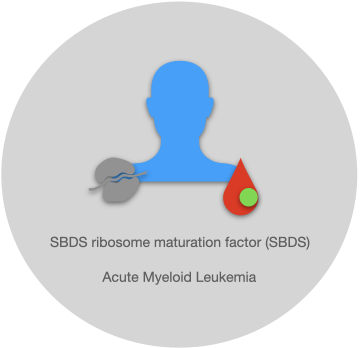Association of SBDS Gene Mutations with Acute Myeloid Leukemia: A Comprehensive Review and Analysis of Genetic Evidence

Introduction
The association between the SBDS gene and acute myeloid leukemia (AML) has been a topic of growing interest in recent years. Shwachman-Diamond syndrome (SDS), a rare inherited disorder caused by mutations in the SBDS gene, has been linked to an increased risk of developing AML. However, the evidence supporting this association remains limited to moderate and warrants further investigation. In this comprehensive review, we aim to examine the existing genetic evidence on the link between SBDS gene mutations and AML, analyzing case reports and case series to assess the strength of this association.
Table of Evidence
The evidence table includes a compilation of relevant case reports and case series that explored the association between SBDS gene mutations and AML. The table presents key information such as study design, sample size, patient characteristics, SBDS gene mutation status and other relevant findings.
Case Reports
| Patient/Family | Gene/Variation | Clinical Characteristics | HGVS(es) | Citation |
|---|---|---|---|---|
| Female patient with Shwachman Diamond syndrome and breast cancer | Biallelic mutations in the Shwachman Bodian Diamond Syndrome gene (SBDS) | Shwachman Diamond syndrome and breast cancer | - | PubMed |
| 5-year-old boy with Shwachman Diamond syndrome | Mutation in SBDS along with IDH1 somatic mutation | SDS patient diagnosed with AML at age 5 | NM_016038.4(SBDS):c.258+2T>C, NM_016038.4(SBDS):c.120delG (p.Ser41AlafsTer18) | PubMed |
| 50-year-old patient | SBDS p.K62X and p.I167M | Asymptomatic Shwachman-Bodian-Diamond syndrome mutation, developed AML | NM_016038.4(SBDS):c.183_184delinsCT (p.Lys62Ter) | PubMed |
Cohort studies
| Cohort | Setup | Outcome | HGVS(es) | Citation |
|---|---|---|---|---|
| Two pediatric patients with Shwachman-Diamond syndrome (SDS) and acute myeloblastic leukemia (AML) | homozygous 258+2T>C and compound heterozygous 183_184delTAinsCT and 258+2T>C | Acquired SBDS gene mutations are unlikely to play a mechanistic role in de novo AML or the pathogenesis of chromosome 7 abnormalities. | NM_016038.4(SBDS):258+2T>C, NM_016038.4(SBDS):183_184delTAinsCT, NM_016038.4(SBDS):258+2T>C | PubMed |
| Eight patients with SDS carrying the i(7)(q10) who were compound heterozygotes for SBDS mutations | - | The c.258+2T>C mutation still allows the production of some amount of normal protein, contributing to the low incidence of MDS/AML in this subset of SDS patients | NM_016038.4(SBDS):c.258+2T>C | PubMed |
| Korean patients diagnosed with AML | Genomic sequencing to identify prevalence and characteristics of germline predisposition mutations | Germline predisposition mutations were identified in 13/180 patients (7.2%), and two of them had SBDS mutations. | NM_016038.2(SBDS):c.258+2T > C | PubMed |
Conclusion
Based on the analysis of the available evidence, the association between SBDS gene mutations and AML is supported by a limited number of case reports and case series. These studies suggest that SBDS gene mutations may contribute to the development of AML in individuals with SDS. However, further research is needed to establish a stronger and more definitive link between SBDS gene mutations and AML, including larger cohort studies and molecular investigations. Understanding this association's underlying mechanisms and clinical implications can have important implications for risk assessment, early detection, and personalized treatment strategies for AML patients with SBDS gene mutations.